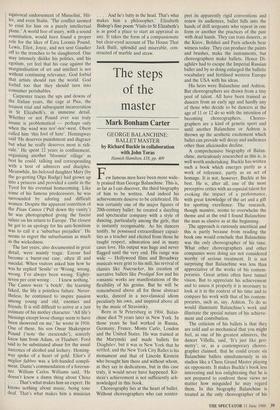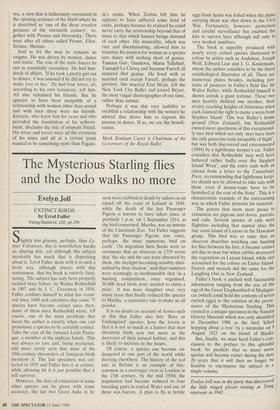The steps of the master
Mark Bonham Carter
GEORGE BALANCHINE: BALLET MASTER by Richard Buckle in collaboration with John Toras
Hamish Hamilton, DS, pp. 409
Few famous men have been more wide- ly praised than George Balanchine. This is, as far as I can discover, the third biography of him to be written. And indeed his achievements deserve to be celebrated. He was certainly one of the major figures of 20th-century ballet: he created a dazzling and spectacular company with a style of dancing, particularly among the girls, that is instantly recognisable. As his dancers testify, he possessed extraordinary capaci- ties as a teacher and elicited from those he taught respect, admiration and in many cases love. His output was huge and never flagged until the very end. His range was wide — Hollywood films and Broadway musicals were grist to his mill; his revival of classics like Nutcracker, his creation of narrative ballets like Prodigal Son and his romantic works are manifestations of the flexibility of his genius. But he will be remembered above all for those abstract works, danced in a neo-classical idiom peculiarly his own, and inspired above all by the music of Stravinsky.
Born in St Petersburg in 1904, Balan- chine died 79 years later in New York. In those years he had worked in Russia, Germany, France, Monte Carlo, London and the United States. He was trained at the Maryinski and made ballets for Diaghilev, but it was in New York that he settled, and the New York City Ballet is his monument and that of Lincoln Kirstein who brought him there and without whom, as they say in dedications, but in this case truly, it would never have happened. Kir- stein's achievement is not sufficiently ack- nowledged in this book.
Choreography lies at the heart of ballet. Without choreographers who can reinter- pret its apparently rigid conventions and renew its audiences, ballet falls into the hands. of drill sergeants who repeat in one form or another the practices of the past with dead hands. They can train dancers, as the Kirov, Bolshoi and Paris schools bear witness today. They can produce the paints and brushes, make the instruments, but choreographers make ballets. Hence Di- aghilev had to escape the Imperial Russian ballet and by so doing enlarged the balletic vocabulary and fertilised western Europe and the USA with his ideas.
His heirs were Balanchine and Ashton.
But choreographers are drawn from a tiny pool of talent. All have been trained as dancers from an early age and hardly any of those who decide to be dancers at the age of 11 or 12 do so with the intention of becoming choreographers. Choreo- graphers are a kind of genetic sport and until another Balanchine or Ashton is thrown up the aesthetic excitement which ballet can provide will decay and audiences other than aficionados decline.
A comprehensive biography of Balan- chine, meticulously researched as this is, is well worth undertaking. Buckle has written such a book which emerges partly as a work of reference, partly as an act of homage. It is not, however, Buckle at his best. He is, after all, one of the most perceptive critics with an especial talent for evoking the impact of a performance, with great knowledge of the art and a gift for spotting excellence. The research, though massive, seems to overwhelm the theme and at the end I found Balanchine the man as elusive as at the beginning.
The approach is curiously uncritical and this is partly because from reading the book one would conclude that Balanchine was the only choreographer of his time. What other choreographers and other companies were doing are not considered worthy of serious treatment. It is not surprising that Balanchine was less than appreciative of the works of his contem- poraries. Great artists often have tunnel vision. But to appreciate his achievement and to assess it properly it is necessary to look at it in the context of his time and to compare his work with that of his contem- poraries, such as, say, Ashton. To do so would illuminate Balanchine's work and illustrate the special nature of his achieve- ment and contribution.
The criticism of his ballets is that they are cold and so mechanical that you might feel, as one of his greatest admirers, the dancer Villella, said, 'It's just like geo- metry'; or, as a contemporary choreo- grapher claimed, that he could create six Balanchine ballets simultaneously in six studios like a Chess Grand Master playing six opponents. It makes Buckle's book less interesting and less enlightening that he is not prepared to confront these views no matter how misguided he may regard them. In this biography Balanchine is treated as the only choreographer of his era, a view that is ludicrously overstated in the opening sentence of the blurb where he is described as 'one of the three creative geniuses of the twentieth century', to- gether with Picasso and Stravinsky. There were after all others called Proust, Eliot, Strauss, Matisse. . . .
And as for the man he remains an enigma. He was driven by women, dance and music. The role of the male dancer he saw as essentially secondary. He had hun- dreds of affairs. 'If he took a pretty girl out to dinner, it was unusual if he did not try to make love to her.' He had four wives; all, according to his own testimony, left him. All also remained his friends. But he appears to have been incapable of a relationship with women other than sexual and with men there were no friends. Kirstein, who knew him for years and who provided the foundation of his achieve- ment, disclaims the title of intimate friend. His wives and lovers were all the creations of his muse and all at a certain point wanted to be something more than Pagani- ni's violin. When Zorina left him he appears to have suffered some kind of crisis, perhaps because he realised he could never carry the relationship beyond that of muse to that which human beings demand of each other. His musicality, which was rare and discriminating, allowed him to translate his passion for woman as a species into dance with nothing short of genius. Tamara Gev, Danilova, Maria Tallchief, Tanaquil Le Clercq and Suzanne Farrell all inspired that genius. He lived with or married each except Farrell, perhaps the greatest. She married Paul Mejia, left the New York City Ballet and joined Mart, the most vulgar choreographer of our time, rather than submit.
Perhaps it was this very inability to establish a relationship with the women he adored that drove him to express his passion in dance. If so, we are the benefi- ciaries.
Mark Bonham Carter is Chairman of the Governors of the Royal Ballet.



































































 Previous page
Previous page